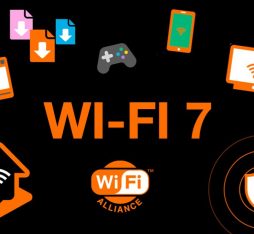“A serious revolution compared to previous standards, focused on improving performance in high-density environments.”
Over the course of its successive versions, the 802.11 standard, which specifies the characteristics of wireless local area networks, or Wi-Fi, has expanded its capabilities, particularly in terms of speed. Some generations stand out as notable technological leaps, and this is the case with Wi-Fi 6 (802.11ax standard).
A standard tailored to high-density environments
Hélène Rallé, Wi-Fi expert at Orange and a delegate to the Wi-Fi Alliance, described it as “a serious revolution compared to previous standards, with significant new features. Wi-Fi 6 focuses less on providing optimal peak throughput, and more on solving a major problem, namely radio congestion caused by the explosion in the number of devices in home networks that are being used at the same time in neighbouring homes. In this respect, the new standard aims above all to improve performance in high-density environments. A second major development involves the launch of the 6-GHz frequency band (Wi-Fi 6E). The standard also brings with it more traditional improvements in throughput, although again this is not its priority.” In practice, moving to the sixth generation of Wi-Fi standards means a whole new user experience, with optimised performance in terms of throughput, latency, and coverage, and a better connection experience in high-density environments, especially in the city centre.
This innovation takes the form of an extender
How will all these paper promises reveal themselves in the home network? At Orange, the innovation teams have designed an extender that takes advantage of the specific features of Wi-Fi 6. The extender replaces the Wi-Fi of older generation Liveboxes via a simple Ethernet connection and extends Wi-Fi coverage to the home. This new hardware consists of three building blocks: “The casing, or covering, which is geared towards sustainable development, with the use of recycled plastic, and designed to facilitate the dismantling and the repair of the extender, explains Pierre-Yves Le Meur, Wifi 6 Extender Project Manager at Orange. The second core element is the circuit board with the Wi-Fi 6 chipsets, provided by Broadcom, a major player in the Wi-Fi ecosystem. Equipped with four antennas, it provides extensive coverage and provides, for example, a throughput that is four times greater than a chipset with a single antenna.” It also uses Wi-Fi 6 technologies: MU-MIMO (multi-users, multi-input, multi-output) to transmit large amounts of data to multiple users at the same time and OFDMA (orthogonal frequency-division multiple access) to divide the frequency band into sub-bands, which are each allocated to a device for the transfer of small data packets. “The last key component is the software, in this case the Smart Wi-Fi solution, developed in collaboration with SoftAtHome, which makes it possible to get an extender that is fully integrated with the Livebox and the existing Wi-Fi network, without having to re-pair every device.”
Smart Wi-Fi: more intelligent and simpler than ever
The Smart Wi-Fi solution brings together a wealth of software intelligence with the overarching aim of improving the Wi-Fi service delivered at home while making it easier to use. It comprises a range of added-value features for users. “Smart Wi-Fi technology incorporates several innovative mechanisms,” explains Yoann Vincent, a product manager at Orange. An Automatic Channel Selection algorithm in particular makes it possible to position the gateway on the best Wi-Fi channel by periodically scanning the Wi-Fi environment of the house. Band Steering then directs devices to the best available Wi-Fi band. At the extender level, other algorithms are involved, such as Client Steering in order to direct devices to the best access point. Smart Wi-Fi also offers simplified installation: auto-configuration of equipment, a single Wi-Fi network with a single name and a single security key across all access points. Using the equipment information, it is also possible to create a map or a typology of connections, which can then be viewed in the Orange MyLivebox application.”
The Wi-Fi environment created by the Wi-Fi 6 extender is optimised in terms of connection performance, as well as in terms of ease of use. These benefits have been observed, proven and extensively tested with 1,000 pilot users in France. This result of this campaign, based on monitoring technical indicators and customer sentiment, was an improved version of the extender.




